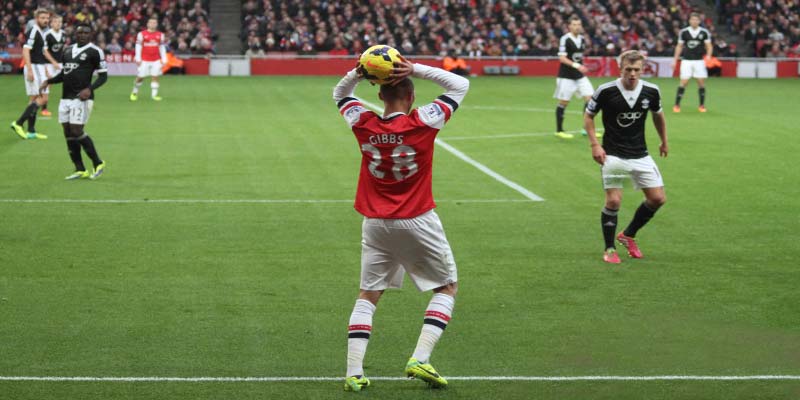
Why the Throw-In Can Change the Game: Unseen Power in Football
Throw-in in Professional Football Matches
In the professional realm of football, the throw-in takes on increased significance. Teams leverage every opportunity to gain a competitive edge, and the throw-in can serve as a tactical asset.
The Significance of Throw-in in Tactics
Professional teams invest considerable time strategizing how to optimize their throw-ins. Players are trained to recognize certain scenarios where a throw-in can create openings. For instance, if a team is trailing late in a match, they may employ a quick throw-in as a means of catching the opposition unprepared, allowing for a swift counterattack.
Moreover, teams often designate specific players as throw-in specialists, akin to set-piece takers. These players possess the skills necessary to deliver accurate and powerful throws, turning a seemingly mundane restart into a weapon for creating scoring chances. Recognizing the importance of throw-ins within tactical frameworks can elevate a team’s performance significantly.
Examples of Successful Throw-in Situations
There are numerous instances in professional football where a decisive throw-in led directly to a goal. Coaches and analysts study these moments to glean insights into effective strategies. For example, some teams have mastered the art of long throw-ins, delivering the ball deep into the opposing penalty area where teammates await for flick-ons and headers.
One memorable example occurred during a high-stakes match in a major tournament. A midfielder executed a rapid throw-in, launching the ball to a forward who quickly turned and laid it off to a teammate. The result? A stunning strike that found the back of the net. Such instances illustrate the importance of thinking on one’s feet and seizing opportunities during throw-ins.
How Professional Teams Utilize Throw-ins
In the world of professional football, teams implement carefully crafted routines for throw-ins. Coaches assess the strengths and weaknesses of their players and design throw-in tactics accordingly. For instance, a team with tall forwards may utilize long throws to create aerial duels in the box, increasing the likelihood of scoring.
Additionally, professional teams frequently employ decoy movements around throw-ins. Players may position themselves strategically to draw defenders away or create space for teammates. By developing a sense of teamwork and synergy around throw-ins, teams can amplify their offensive capabilities, capitalizing on even the smallest opportunities presented during a match.
The Impact of Throw-in on Match Results
Delving deeper into the impact of throw-ins reveals just how crucial they can be in determining the outcome of a match. Correctly executed throw-ins can shift the momentum in favor of a team, while errors can lead to lost possession and missed opportunities.
The Difference Between Correct and Incorrect Throw-ins
The disparity between a correct and incorrect throw-in extends beyond mere possession; it can ultimately alter the game’s trajectory. A correct throw-in can build momentum, allowing a team to maintain pressure on their opposition. Conversely, an incorrectly executed throw-in can lead to loss of momentum and confidence among players.
Consider a scenario where a team finds itself under intense pressure. An inaccurate throw-in could result in immediate counter-pressure from the opposing team, leading to a significant scoring opportunity. Being aware of this dynamic is vital for players, emphasizing the need for precision and consideration even during seemingly simple restarts.
Improving Throw-in Skills for Players
Given the importance of throw-ins, players should focus on improving their skills through targeted practice. Engaging in drills that emphasize technique can enhance overall proficiency. For example, practicing various angles and distances can help players become versatile throwers, capable of adapting to different in-game situations.
Furthermore, players should work on their decision-making abilities, learning to read the game in real-time. Developing spatial awareness ensures that they can maximize the effectiveness of their throw-ins, spotting opportunities and threats alike. Additionally, watching professional matches and analyzing successful throw-in scenarios can provide valuable insights into best practices.
Conclusion
The throw-in is far more than just a mundane aspect of football; it is a critical component that reflects the complexities of the game. From its historical roots to its modern-day implications, understanding the rules, techniques, and tactical significance of throw-ins enriches one’s appreciation for football.
As we continue to witness the evolution of this beloved sport, players and teams must recognize the power of throw-ins as strategic tools. With careful execution and thoughtful planning, throw-ins can turn the tide of a match, igniting passion and excitement among players and fans alike. Ultimately, mastering this oft-overlooked skill can contribute enormously to a player’s overall effectiveness on the pitch, shaping their journey in the beautiful game.



